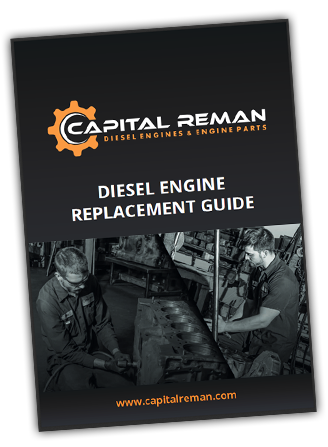Cummins N14 Specs, History and Problems
Cummins N14 Engine History
 The Cummins N-14 is a great engine; quite possibly the best Cummins engine ever produced. These engines are the stuff dreams are made of if you’re an old school guy looking for reliability. No doubt, the N14 is part of “1,000,000 mile club”. The engine features the best of engineering fundamentals mixed with one of the first electronic control system. First designed in the late 1980s it was sent into full production in 1991. The N14 engine is the follow up to the vastly popular Cummins 855 Big Cam which was produced 1976-1985. Cummins listened to it customers and designed a more powerful version of the 855 while maintaining a similar profile and bore/stroke architecture. Overall, the biggest structural difference between the 855 and N14 is the air-to-air cooling system changes but both engines are very similar.
The Cummins N-14 is a great engine; quite possibly the best Cummins engine ever produced. These engines are the stuff dreams are made of if you’re an old school guy looking for reliability. No doubt, the N14 is part of “1,000,000 mile club”. The engine features the best of engineering fundamentals mixed with one of the first electronic control system. First designed in the late 1980s it was sent into full production in 1991. The N14 engine is the follow up to the vastly popular Cummins 855 Big Cam which was produced 1976-1985. Cummins listened to it customers and designed a more powerful version of the 855 while maintaining a similar profile and bore/stroke architecture. Overall, the biggest structural difference between the 855 and N14 is the air-to-air cooling system changes but both engines are very similar.
The N-14 was produced until 2001 and saw many changes over its 10+ year run for Cummins. The most radical change over the 855 was the incorporation of the electronic control module (ECM). Detroit Diesel rolled out the first commercial electronic diesel engine in 1987 with its ground breaking Series 60 Engine and Cummins followed suit. With the advent of the first EPA Tier emissions regulations in 1994 the future of diesel engines was going to be electronic diagnostics. The N14 Celect was the first Cummins engine to feature an electronic injection system. The Celect fuel system produces systematic pressure throughout each injection cycle unlike the common rail fuel system of the 855, or older M11 or L10 models. Albeit the injectors are still cam actuated the ECM controls the metered flow of fuel to the injectors. In 1997 Cummins introduced the N14 Celect Plus which further fine-tuned the ECM to control many more custom parameters of the fuel system. In addition of an ECM the N14 was designed for emissions purposes to consume much less oil. The N14 diesel was engineered in a way where oil flow is much more uniform thus requiring the engine to consume about 20%-30% less oil than the Cummins 855. Engineers at Cummins also came up with new pistons that positioned the top ring much closer to the uppermost part of the piston. This new design reduced a large open space between the ring and the piston liner. By utilizing this space the combustion chamber moved closer to the top ring which meant the oil got much hotter and burned off more completely. In addition to internal changes, engineers also developed an API CF-4 and API CG-4 oilfor the N14 that was much more thermally stable and easier to breakdown on a molecular level.
In addition of an ECM the N14 was designed for emissions purposes to consume much less oil. The N14 diesel was engineered in a way where oil flow is much more uniform thus requiring the engine to consume about 20%-30% less oil than the Cummins 855. Engineers at Cummins also came up with new pistons that positioned the top ring much closer to the uppermost part of the piston. This new design reduced a large open space between the ring and the piston liner. By utilizing this space the combustion chamber moved closer to the top ring which meant the oil got much hotter and burned off more completely. In addition to internal changes, engineers also developed an API CF-4 and API CG-4 oilfor the N14 that was much more thermally stable and easier to breakdown on a molecular level.
Cummins N-14 Injector Problems
 For all of the great aspects of the Cummins N14 its Achilles Heel has always been the injectors. The L10, M11 and N14 all have problems with injector failures and the surrounding electronics. The fuel system’s main components consists of the injectors, injector wiring harness and the ECM. A common occurrence will happen when, for example, when the ECM shows a 111 or 343 code in an N-14 Celect Plus model. This means the ECM isn’t grounded to the injector. Usually this starts out with only 1 injector shown to be malfunctioning but can quickly spread to others. If this happens you immediately want to shut down the engine.
For all of the great aspects of the Cummins N14 its Achilles Heel has always been the injectors. The L10, M11 and N14 all have problems with injector failures and the surrounding electronics. The fuel system’s main components consists of the injectors, injector wiring harness and the ECM. A common occurrence will happen when, for example, when the ECM shows a 111 or 343 code in an N-14 Celect Plus model. This means the ECM isn’t grounded to the injector. Usually this starts out with only 1 injector shown to be malfunctioning but can quickly spread to others. If this happens you immediately want to shut down the engine.
These early electronic engines offered no protection against the wiring harness shortening out. There are 6 injector driver connections on the ECM which are attached to the injectors via a wiring harness. If an injector goes bad it is advised to pull out the wiring from the injector and replace immediately before the faulty wire burns up the ECM motherboard. Usually if you unplug # 1, 2, 3, or 4 injector drivers in time you can save the ECM/injectors. The wiring harnesses are known to have problems and are very expensive to replace.
Another issue with the N14 ECM is a faulty fuel solenoid. The solenoid is situated on the bottom of the ECM. If the solenoid shorts it will heat up the ECM slowly and can then destroy the entire fuel solenoid circuit, memory chip and the injector timing chip. Usually the solenoid gets so hot it melts the solder on the chips. For a 50 pin connection all it takes is one pin to loosen from the heat to destroy the ECM. It is recommended that drivers carry 1-2 extra injectors in the truck in case one goes out. Usually they go out in pairs which makes sense to carry 2 at all times.
Other common injector issues with the N-14 include:
• Injectors overfill with fuel and it overfills the crankcase
• Injector O-Rings will leak
• Misfires occurring due to a clogged filter screen on top of the injector pump • Injector cup failures allow water in the fuel
• Injector cup failures allow water in the fuel
• Over revving can cause scoring on the injector plunger barrel
• Oil Coolers are prone to clogging
• Fuel lines prone to fraying allowing debris into the injector
The type of fuel and additives used with the N-14 make a world of difference. Many fleet operators use Lucas oil additives or Automatic Transmission Fluid (ATF) Liquid Moly solutions. ATF additives prevent oil loss, helps protect and regenerate seals and rings, cleans out oil sludge, improves steering performance and helps protect the engine during shifting. Most operators will put in 1 quart of ATF per 100 gallons of fuel. However it is important to note ATF Fluid is red in nature and will show up as off-road fuel at most DOT Weight Stations. You could end up with some pretty big fines if you don’t have the proper documentation. Other preventative measures with the N-14 include using an alcohol based additive to kill off algae from newer blends of fuel. The algae in these various blends tends to eat through the older OEM fuel lines. If you use winter and summer blend diesel fuels make sure to use blends from a reputable supplier instead of some discount brand as the N-14 doesn't do well with overly chemically blended fuels; the basic stuff will do just fine.
Even though the N14 has some injector issues make no mistake the N14 is a workhorse. This diesel enginehas the power to get the job done, is easy to maintain and will last a long time. It is recommended that the oil filter, fuel filter and coolant filters all be replaced every 11,500 miles. The N-14 does not do well with cheaper filters that don’t further remove particulate matter. The early Cummins ISB series engines, (5.9 L and 6.7 L) were known to ship with cheaper less efficient filters which were also used in the early N-14 engines as well. Fleetguard or Donaldson makes a fine aftermarket filter for newer replacement purposes. Other than the fuel filters it is recommended that the valves be adjusted every 125,000 miles but a major overall should not be needed for 500,000 – 1,000,000 miles.
N-14 Engine Specs
 The N-14 comes in the models the: N-14, N-14 Celect and N-14 Celect Plus.
The N-14 comes in the models the: N-14, N-14 Celect and N-14 Celect Plus.
• Displacement: 14.0 Liter
• Bore: 5.5”, 140 mm
• Stroke: 6.0”, 152 mm
• Cylinders: 6 In-Line
• Fuel System: PT
• Horsepower: 310 - 525 HP @ 2100 RPM, 360 HP @ 1800 RPM Marine
• Power Rating: 231 - 391 kW standard, 269 kW Marine
• Aspiration: Turbocharged / Waterjacket Aftercooled / Naturally Aspirated Options
• Rating Type: Continuous
• Dry Weight: 2800 lbs., 1300 kg
• Dimensions: Length 59 in, 1496 mm, Width 33 in, 854 mm, Height 51 in, 1293 mm.
• Compression Ratio: 17:1
• Injector Firing Order: 1-5-3-6-2-4
• Valve Timing: A Mark Cylinder 1-6, B Mark Cylinder 5-2, C Mark Cylinder 3-4
• Clearances: Intake Valves: 14 thousands, Exhaust Valves: 27 thousands
• Emissions Certifications: Meets NOx requirements International Maritime Organization (IMO), Maripol 73/78 Annex VI Regulation 13 and the United States Environmental Protection Agency.




